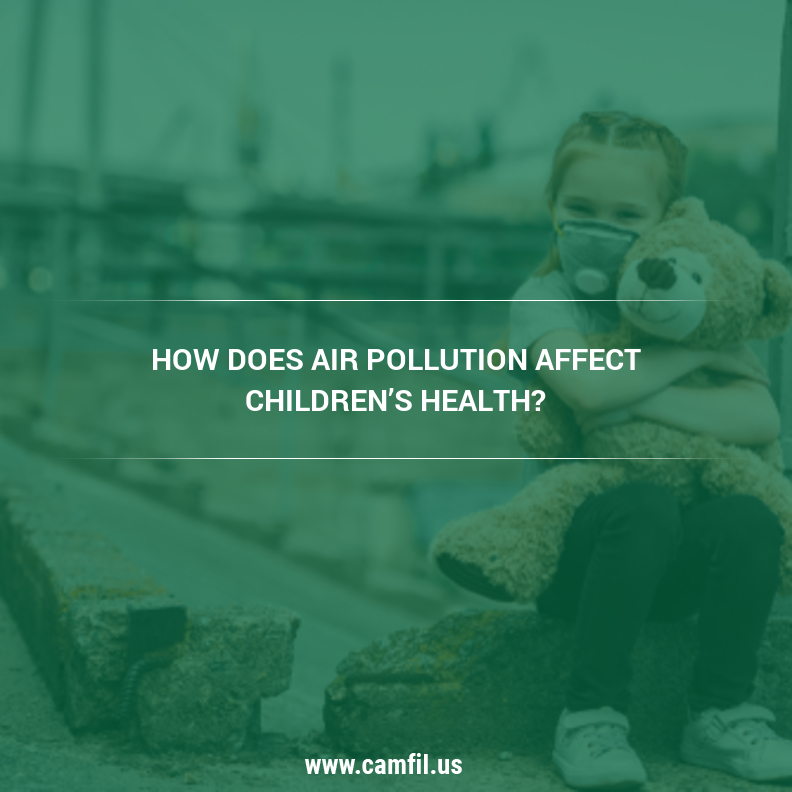It’s known that poor outdoor and indoor air quality is responsible for killing around 600,000 children each year. Learn how home air filters can help.
According to the World Health Organization (WHO), air pollution, both from indoor and outdoor sources, is responsible for approximately seven million premature deaths around the world. To protect themselves and their families, people are turning to home air filters designed to capture and remove airborne contaminants inside indoor spaces. Recent studies, however, suggest that these pollutants may have varying effects on groups of people.
How Air Pollution Affects Children’s Health
For starters, it is a known fact that the elderly, pregnant women, individuals with existing health conditions, and children face greater dangers from exposure to air pollution.
“Children are more vulnerable to air pollution because they breathe more than adults per unit of body weight,” Camfil USA’s Charlie Seyffer, Manager of Marketing & Technical Materials for commercial air filters and 37-year ASHRAE member and active committee participant. “Children’s airways and lungs are still developing and they have detoxification rates and immature immune and defense systems.”
And the fact that many children spend a lot of time outdoors playing and practicing sports only adds to the disproportionate risk they face when exposed to poor outdoor air quality. The majority of children also live in urban areas with higher levels of contaminants produced by vehicles, industries and other human activity.
Asthma in Children and the Connection to Outdoor and Indoor Air Quality
While the Cleveland Clinic notes that more children are indeed developing asthma at an early age, it doesn’t exactly know why. Some experts suggest that this may have to do with family history and exposure to allergens and cigarette smoke before and after birth. In any case, what experts do know is that children and young adults with underlying chronic health conditions like asthma face a greater risk of being affected by poor outdoor and indoor air quality.
Aside from the fact that their lungs tend to be weaker from asthma, children have faster breathing rates, which means they are not only breathing in more air, but also more air pollution. As this happens, it can have disastrous effects on their still-developing lungs.
The next point further elaborates on this point.
Protecting Lung Development with Home Air Purifiers
The installation of home air purifiers in homes may also protect the crucial stages of children’s lung development.
Studies show that air pollution can have a dramatic effect on lung development, with children between the ages of 8 to 10 and living in highly polluted areas having lung capacity reduced by as much as 10 percent than normal. While more research has to be done to determine if this effect can be reversed, researchers expressed concerns that this reduced lung function may never recover to normal capacity, even when the child has been moved to a location with better air quality.
Components of air pollution that are known to irritate the lungs or trigger allergic reactions include particulate matter (PM), ozone, sulfur dioxide, volatile organic compounds, and nitrogen oxides among many others. The good news is that home air purifiers are designed to capture and remove these pollutants from indoor spaces.
Home Air Purification Systems May Also Reduce the Risk of Obesity and Diabetes
While much of the attention about air pollution tends to be focused on its effects on lung and heart function, there is evidence to suggest that clean air ‘treated’ by home air purification systems may also reduce the risk of children becoming obese and developing type 2 diabetes.
In one study, researchers found that children between the ages of 8 to 15 who were exposed to higher concentrations of airborne pollutants developed a lower sensitivity to insulin. The same group of children was also found to have reduced beta-cell function and an above average body mass index (BMI) by the time they turned 18.
If anything, this proves that air pollution also affects the immune and metabolic systems of children. Scientists believe this may be due to how fine particulate matter (PM), specifically PM2.5 or particles that are 2.5 microns in size or smaller, are tiny enough to enter the lungs and cross into the bloodstream, reaching the body’s vital organs as a result.
Home Air Filtration Systems and Autism
Pregnant women may also have a special need for home air filtration systems, this after one study published in the journal Environmental International found that air pollution exposure may increase a child’s risk of developing autism spectrum disorder (ASD) by up to 78 percent.
The study is far from conclusive, however, as the researchers admit that identifying the actual causes of autism is a tremendous task given the complexity of the disorder. Aside from environmental factors like air quality, water and diet, factors such as genetics and drug use may also play a role in the risk of developing autism.
Are Home Air Purifiers with HEPA Filtration Systems Worth It?
Given the host of health issues that children may experience after being exposed to air pollution, it’s clear that parents can’t go wrong installing home air purifiers with HEPA filtration systems in their households. It’s crucial, however, to choose an air purification system from a trusted manufacturer, which ensures the solution is actually appropriate for the contaminant issues and size of the rooms.
When in doubt, get in touch with the air filtration experts of Camfil USA. Contact our offices to learn what Camfil home air filters can do for your indoor air quality. You can also find more topics on clean air solutions by visiting our blog.
Media Contact:
Lynne Laake
Camfil USA Air Filters
T: 888.599.6620
F: Friend Camfil USA on Facebook
Y: Watch Camfil Videos on YouTube
The post The Benefits of Home Air Filters for Children’s Health appeared first on Air Filters for Clean Air.

